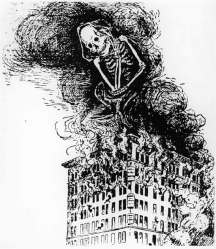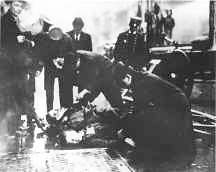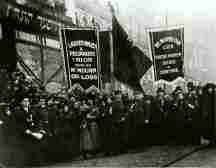The Triangle Shirtwaist Factory Fire. http://www.ilr.cornell.edu/trianglefire. Editors: Hope Nisly and Patrizia Sione; Editorial Assistant: Melissa Holland; Photograph Editor: Paulette Manos; Web design: David DeMello and Linda Fisher. The Kheel Center for Labor-Management Documentation and Archives at Cornell University in cooperation with the Union of Needletrades, Industrial and Textile Employees, AFL-CIO (UNITE), 1998.
On March 25, 1911, a fire, which broke out on the top floors of the 10-story Asch Building in lower Manhattan, New York, killed 146 of the 500 employees of the Triangle Shirtwaist Company in one of the worst industrial disasters in the nation's history. These factory workers, mostly young female immigrants from Europe working long hours for low wages, died because of inadequate safety precautions and lack of fire escapes. As a result of the Triangle fire, the International Ladies’ Garment Workers Union (ILGWU), the union to which some of the Triangle workers belonged, stepped up its organizing efforts and fought to improve working conditions for garment workers. Also a public outcry prompted the New York State Legislature to appoint a commission to investigate the causes of the fire. The commission's investigation, and union organizing, eventually led to the introduction of fire-prevention legislation, factory inspections, liability insurance, and better working conditions for all workers. The Kheel Center for Labor-Management Documentation and Archives at Cornell University, in cooperation with the Union of Needletrades, Industrial and Textile Employees (UNITE), have created a Web site on the Triangle Shirtwaist Company fire at http://www.ilr.cornell.edu/trianglefire. The site, the designers proclaim, was made "specifically to assist high school students in writing a research paper from primary sources." Not only does the Triangle fire Web site admirably carry out this modest aim, but it also provides an excellent resource for the teaching of a variety of American history courses, contains a valuable collection of primary documents for professional historians who want to research workers’ lives, and shows the potential of the World Wide Web for introducing a wider audience to the impact of labor unions on American history. From the home page of this site viewers may click onto a variety of essays, primary documents, photographs and audio
Viewers can also use the site to listen to audio recordings of three survivors of the fire. These interviews with Max Hochfield, Dora Maizler, and Pauline Pepe range from 20 minutes to over 40 minutes in length and provide some valuable insights into the working lives of people in early 20th-century New York. Rather confusingly, the next option, "The Triangle Fire," opens up to a mixed bag of documents that includes sections from Leon Stein's book, Out of the Sweatshop, cuttings from The New York Times, The Chicago Tribune, and the Ladies’ Garment Worker, and a number of photographs and cartoons the viewer has already seen on the previous option on the site. By clicking on "Relief Work and Investigative Activities" the viewer finds excerpts from the reports of The New York (State) Factory Investigating Commission and commentaries on the Commission's findings by the American Federationist, the Ladies’ Garment Worker and the Literary Digest. A section on "Mourning the Dead" includes more excerpts from Leon Stein’s Out of the Sweatshop and his other book, The Triangle Fire, highlighting public reaction to the fire. There is also a wonderful bibliography on the fire which includes archive sources for scholars wishing to carry out original research, and a host of secondary sources including juvenile literature, fiction and poetry, videos, and instructional materials for middle and high school students. Finally, there are links to other Web sites which include further material on the Triangle fire, an American Federation of Labor-Congress of Industrial Organizations (AFL-CIO) history of the American labor movement article, and the official Web site of UNITE.
Overall, the designers of this Web site have done a wonderful job in depicting the horror, sadness, and anger that the Triangle fire of 1911 ignited in New Yorkers. The site could be used by professional researchers, and those teaching courses in urban history, labor history, and American history, and will hopefully stimulate high school students and others to further investigate the history of the American labor movement.
John F. Lyons ~ End ~ Web Site Review of The Triangle Shirtwaist Factory Fire Comments | JMMH Contents |


